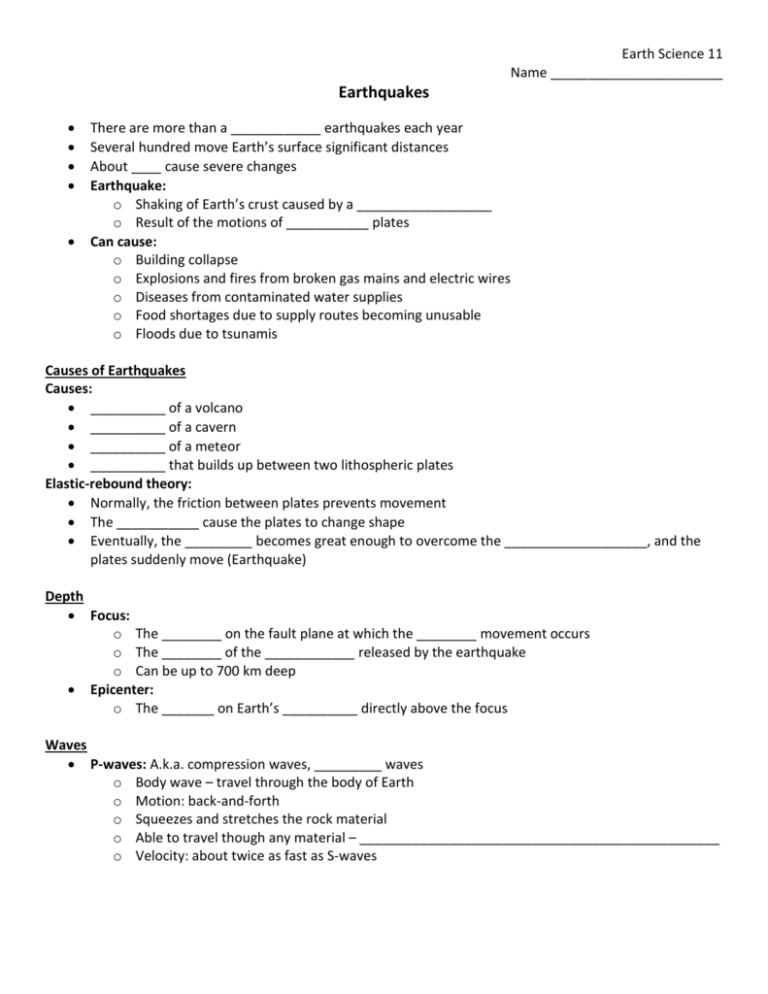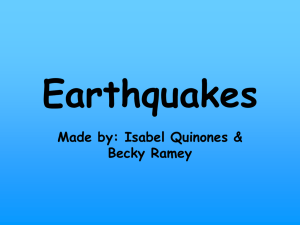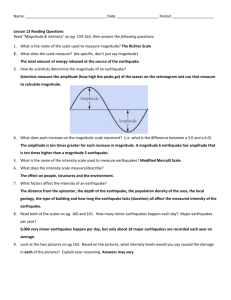Earthquakes - WordPress.com
advertisement

Earth Science 11 Name _______________________ Earthquakes There are more than a ____________ earthquakes each year Several hundred move Earth’s surface significant distances About ____ cause severe changes Earthquake: o Shaking of Earth’s crust caused by a __________________ o Result of the motions of ___________ plates Can cause: o Building collapse o Explosions and fires from broken gas mains and electric wires o Diseases from contaminated water supplies o Food shortages due to supply routes becoming unusable o Floods due to tsunamis Causes of Earthquakes Causes: __________ of a volcano __________ of a cavern __________ of a meteor __________ that builds up between two lithospheric plates Elastic-rebound theory: Normally, the friction between plates prevents movement The ___________ cause the plates to change shape Eventually, the _________ becomes great enough to overcome the ___________________, and the plates suddenly move (Earthquake) Depth Focus: o The ________ on the fault plane at which the ________ movement occurs o The ________ of the ____________ released by the earthquake o Can be up to 700 km deep Epicenter: o The _______ on Earth’s __________ directly above the focus Waves P-waves: A.k.a. compression waves, _________ waves o Body wave – travel through the body of Earth o Motion: back-and-forth o Squeezes and stretches the rock material o Able to travel though any material – ________________________________________________ o Velocity: about twice as fast as S-waves S-waves: A.k.a. shear waves, ___________ waves o Body wave o Motion: side-to-side o Causes particles to move at right angles to the direction the wave is travelling o Able to travel through __________ only L-wave: __________ wave o Motion: like ripples on a pond o Travel slower than P-waves or S-waves Seismograph Seismograph: ________________ that detects and ____________ earthquake waves o Record horizontal/vertical motions Seismogram: The ___________ that records earthquake activity o The first major zig-zag on the seismogram is the arrival of the P-wave (moves the fastest) o The larger the zig-zag, the bigger the earthquake Magnitude Seismograms can be used to determine the strength (magnitude) of the energy produced by the earthquake Richter scale: o Developed by Charles F. Richter in the 1940’s o ______________ the amount of ___________ released by the earthquake o Each _______________ number represents an earthquake ____ times stronger than the next _________ number o Ex. A magnitude 6 is 32 times stronger than a magnitude 5, and 1024 times stronger than magnitude 4 Seismic moment: o Harder to measure than the Richter magnitude o More accurate indicator of the total energy involved o Ex. The 1906 San Francisco earthquake and 1964 Alaskan earthquake both had Richter magnitude 8.3. However, the San Francisco earthquake had a seismic moment of 7.9; the Alaskan earthquake 9.2. The Alaskan quake was stronger than the San Francisco quake.







